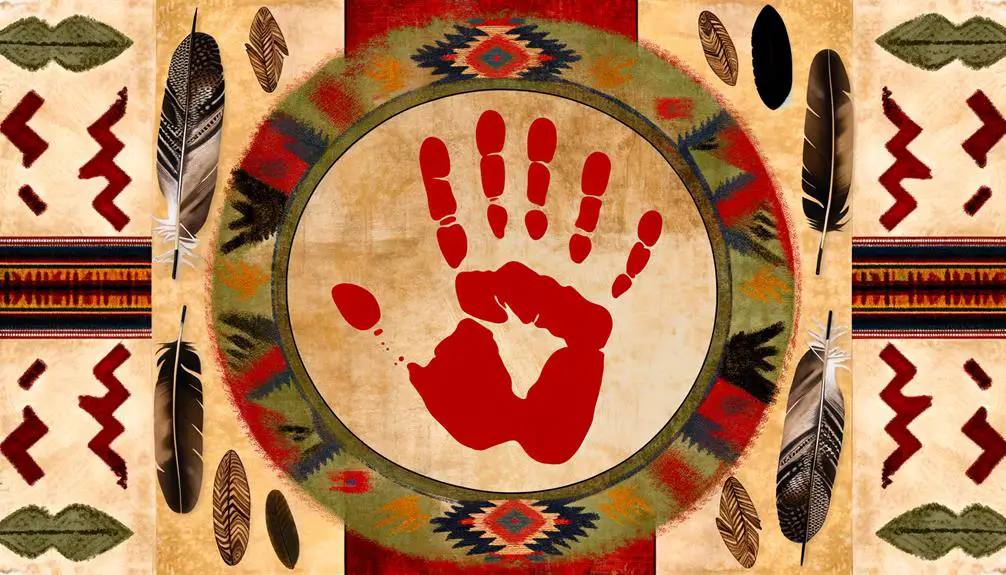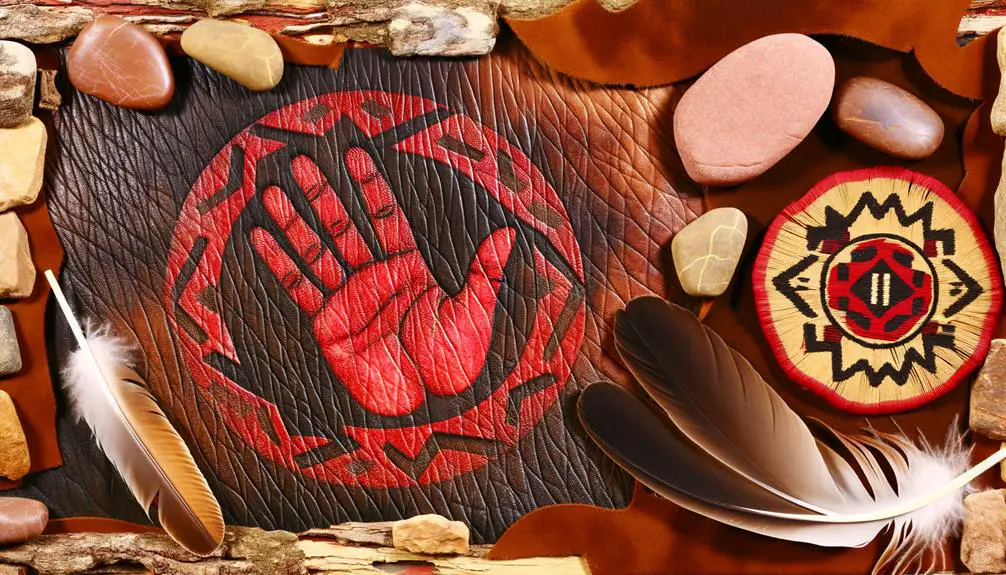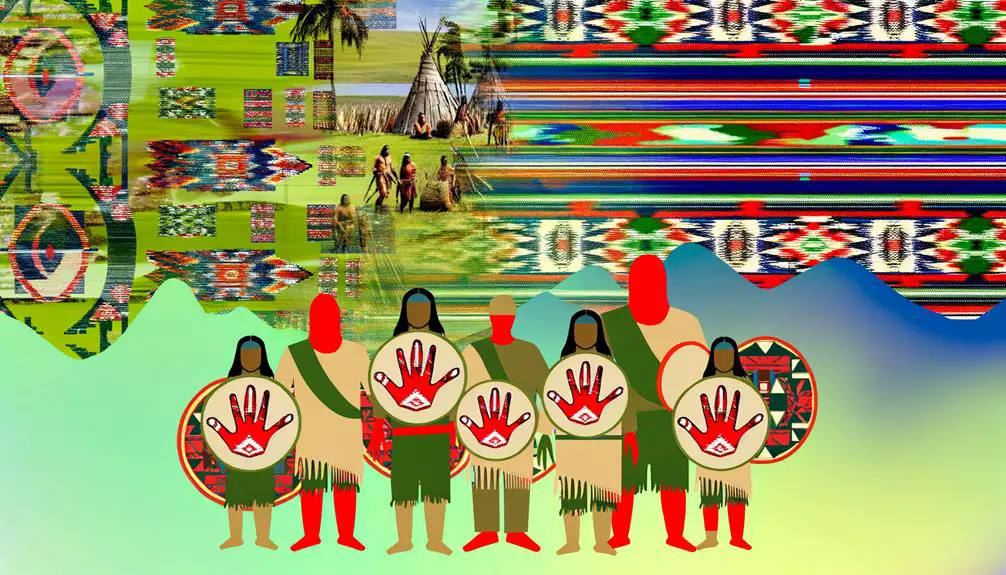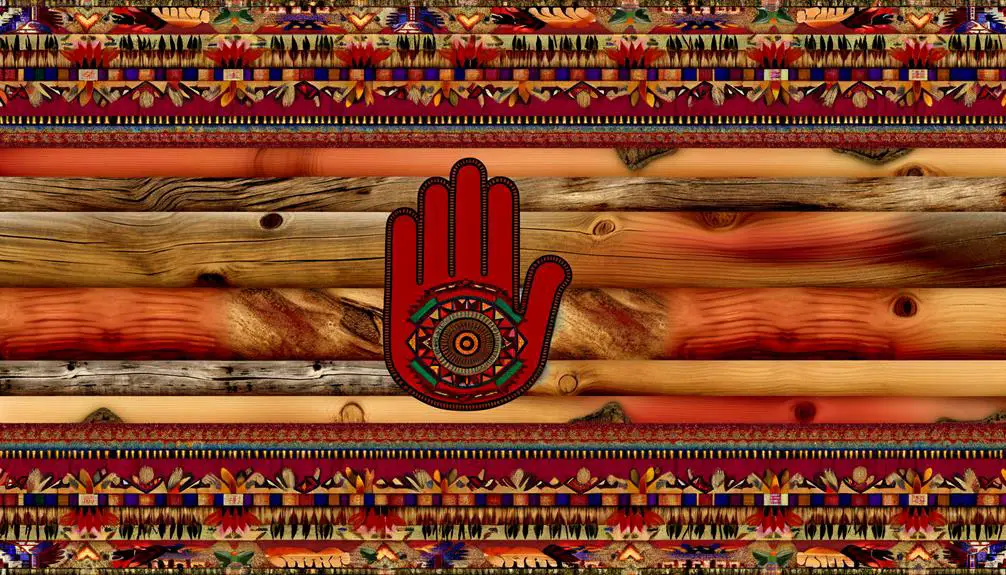Decoding the Meaning of the Native American Red Hand Symbol
The Red Hand symbol, deeply rooted in Native American culture, originates from ancient indigenous traditions, signifying protection, identity, and societal structure. Ethnographic studies reveal its use in rituals and rock art, varying across tribes: Plains tribes associate it with warrior prowess; Southwestern tribes view it as protective; Great Basin tribes link it to survival; and Southeastern tribes see it as communal strength.
Modern interpretations recontextualize it for movements like advocating for missing and murdered Indigenous women. Through its historical, cultural, and political dimensions, the Red Hand remains a poignant emblem of resistance and memory.
Exploring further offers rich insights into its enduring significance.

Key Takeaways
- The Red Hand symbol signifies protection, identity, and spiritual connection in ancient and modern Native American communities.
- Different tribes interpret the Red Hand variably, linking it to warrior bravery, spiritual guidance, resilience, and communal strength.
- It serves as an emblem of resistance against colonization, representing Indigenous sovereignty and self-determination.
- The symbol is integral to honoring ancestral sacrifices and maintaining cultural heritage through ceremonial artifacts and memorial sites.
- Modern usage includes advocacy for missing and murdered Indigenous women (MMIW) and other socio-political issues, symbolizing solidarity and resilience.
Historical Origins

The historical origins of the Native American Red Hand symbol can be traced back to ancient traditions and practices deeply embedded in the cultural and spiritual life of various indigenous tribes.
Ethnographic records and archaeological findings indicate that this symbol was utilized in rituals, ceremonies, and as a form of visual communication. The Red Hand, often seen on rock art and pottery, served as both a protective emblem and a mark of identity within tribal communities.
Its use spanned across numerous regions, from the Southwestern tribes such as the Navajo, to the Eastern Woodland tribes. This widespread adoption suggests a shared understanding of its significance, reflecting a complex interplay of belief systems and societal structures that governed Native American life.
Cultural Significance

The cultural significance of the Native American Red Hand symbol is multifaceted, encompassing historical context and evolution, its role in rituals, and contemporary interpretations.
Understanding this symbol requires an exploration of its origins and transformations over time, revealing its enduring presence in various ceremonial practices.
In addition, examining how modern Native American communities interpret and utilize the Red Hand symbol provides insight into its ongoing relevance and adaptation.
Historical Context and Evolution
Rooted in ancient traditions, the red hand symbol has evolved through centuries, embodying profound cultural significance among various Native American tribes.
Historically, it is believed to have represented a myriad of concepts, from protection and power to life and death. Early ethnographic records reveal its use in rock art, pottery, and ceremonial attire, signifying its wide-reaching importance.
Over time, the symbol's meaning adapted, reflecting the dynamic social and spiritual contexts of the tribes. The red pigment, often derived from ochre, was not merely decorative but imbued with spiritual potency.
The evolution of this symbol underscores its enduring relevance, continuously shaping and expressing the identities and beliefs of Native American communities across generations.
Symbolism in Rituals
In numerous Native American rituals, the red hand symbol emerges as a potent emblem of spiritual invocation and communal identity. This symbol is deeply embedded in ceremonies that honor ancestors, seek protection, or invoke blessings. The red hand is often painted on sacred objects, clothing, or directly onto the body, signifying power, courage, and the life force.
| Ritual Context | Symbolic Meaning |
|---|---|
| Ancestral Worship | Connection to lineage |
| Warrior Ceremonies | Strength and bravery |
| Healing Practices | Vitality and health |
| Vision Quests | Spiritual guidance |
Ethnographic accounts reveal that the red hand's vivid color and form resonate with the elemental forces, reflecting a cosmology where the physical and spiritual worlds are intertwined. Through such rituals, communities reinforce their cultural narratives and spiritual cohesion.
Contemporary Interpretations
How has the red hand symbol evolved in contemporary Native American communities, reflecting both continuity and adaptation within their cultural practices?
This symbol, historically integral to rituals and ceremonies, has been recontextualized to address modern socio-political issues.
For example, the red hand has been prominently featured in movements advocating for missing and murdered Indigenous women (MMIW), symbolizing both loss and resilience.
This adaptation signifies the enduring relevance of the red hand while imbuing it with new layers of meaning pertinent to contemporary struggles.
Ethnographic studies reveal that this symbol serves not only as a cultural touchstone but also as a powerful emblem in the ongoing fight for justice and recognition within Native American communities.
Tribal Variations

The interpretation and significance of the Red Hand symbol exhibit considerable diversity across different Native American tribes, reflecting each group's unique cultural narratives and historical experiences. For instance, among the Plains tribes, the Red Hand often symbolizes a warrior's bravery and prowess in battle. Conversely, in Southwestern tribes, the symbol may be associated with protection and spiritual guidance. The Great Basin tribes regard it as a mark of survival and resilience, while the Southeastern tribes use it to signify communal strength and unity.
| Tribe Region | Symbol Meaning |
|---|---|
| Plains | Warrior's bravery and battle prowess |
| Southwestern | Protection and spiritual guidance |
| Great Basin | Survival and resilience |
| Southeastern | Communal strength and unity |
This ethnographic diversity underscores the rich, multifaceted nature of Native American symbolism.
Symbol of Resistance

Beyond its varied tribal interpretations, the Red Hand symbol also emerges as a powerful emblem of resistance among Native American communities.
Historically, it has been employed as a visual assertion against colonization, cultural erasure, and systemic injustices. Ethnographic accounts reveal that the symbol often appears in protests, rallies, and art, signifying collective resilience and defiance.
Its usage transcends individual tribes, uniting diverse Native groups in a shared narrative of struggle and perseverance. The Red Hand serves not merely as an artistic or spiritual icon, but as an active statement of Indigenous sovereignty and self-determination.
This symbolic resistance underscores a broader socio-political movement aimed at reclaiming identity, rights, and cultural heritage against ongoing marginalization.
Remembrance and Honor

The red hand symbol holds profound historical significance within Native American cultures, serving as a poignant reminder of ancestral struggles and sacrifices.
Today, this emblem is incorporated into various ceremonial practices, underscoring its role in honoring the memory of those who have come before.
Symbolic Historical Significance
Embodying a profound legacy, the Native American Red Hand symbol is imbued with historical significance, serving as a poignant reminder of past struggles and a tribute to the resilience and honor of indigenous communities. This emblematic mark is a reflection of the enduring spirit and cultural continuity of Native American societies.
Its historical significance can be elucidated through several key aspects:
- Historical Recording: Used on artifacts and structures, the symbol preserves the narratives of ancestral battles and victories.
- Cultural Identity: It reinforces a shared identity, connecting contemporary Native Americans with their forebears.
- Resilience: Symbolizes the collective endurance and survival amidst colonization and forced assimilation.
These elements underscore the Red Hand's lasting relevance and its role in honoring a resilient heritage.
Ceremonial Uses Today
In contemporary Native American ceremonies, the Red Hand symbol is frequently utilized as a potent emblem for remembrance and to honor ancestors. This emblem often appears in rituals and gatherings, symbolizing the enduring connection between the living and those who have passed.
Ethnographic accounts illustrate its use in various tribal rituals, where it serves not merely as an artistic motif but as a sacred marker of respect and continuity. The Red Hand's vivid presence on ceremonial objects, regalia, and sacred spaces underscores its role in invoking ancestral spirits, fostering communal memory, and reinforcing cultural identity.
Its application in these contexts affirms a deep-seated reverence for lineage and the perpetuation of collective heritage within Native American communities today.
Preserving Cultural Heritage
Preserving cultural heritage within Native American communities involves intricate practices of remembrance and honor, where symbols like the Red Hand play a pivotal role. This symbol serves not only as a visual representation of historical narratives but also as a living attestation to collective identity.
The Red Hand is often integrated into ceremonial artifacts. Items such as drums, shields, and clothing adorned with the Red Hand symbolize protection and ancestral guidance.
Memorial sites also prominently feature the Red Hand. Monuments and sacred spaces frequently incorporate this symbol to honor the memory of those who have passed and to affirm that their stories endure.
Additionally, educational programs play a crucial role in cultural preservation. Initiatives that teach younger generations about the Red Hand foster a deeper understanding and continuity of traditions.
This multi-faceted approach affirms that the heritage remains vibrant and respected.
Artistic Depictions

Artistic depictions of the Native American Red Hand symbol often serve as profound visual representations of cultural identity, resistance, and historical memory. These depictions, found in various mediums such as pottery, textiles, and rock art, encapsulate narratives of perseverance and defiance.
Each artistic portrayal varies across different tribes, reflecting unique regional and cultural contexts. Ethnographically, the symbol's integration into ceremonial attire and artifacts underscores its role in communal identity and spiritual practices. The red hand frequently appears in sacred spaces, emphasizing its protective and communicative functions.
These visual articulations not only preserve ancestral knowledge but also provide a rich tapestry of indigenous expression, offering deep insights into the lived experiences and historical struggles of Native American communities.
Modern Interpretations

Examining contemporary understandings of the Native American Red Hand symbol reveals its evolving significance within both indigenous communities and broader societal discourses. Today, this emblem is often reinterpreted to highlight various social and cultural issues.
Its modern applications encompass:
- Advocacy for Missing and Murdered Indigenous Women (MMIW): The Red Hand is prominently utilized to raise awareness and mobilize action against the violence faced by Indigenous women.
- Cultural Revival: This symbol is being reclaimed in efforts to revitalize and affirm Native American cultural identity and heritage.
- Political Activism: The Red Hand is employed in various forms of protest and resistance, symbolizing solidarity and resilience among Indigenous populations.
These contemporary usages underscore the symbol's dynamic and multifaceted role in modern contexts.
Red Hand in Media

The depiction of the Native American Red Hand symbol in various media forms, including film, literature, and visual arts, serves to both educate and influence public perception regarding Indigenous issues and cultural narratives. This symbol often emerges in contexts that highlight resistance, identity, and historical trauma, reflecting a broader commitment to social justice and historical integrity. Analyzing its presence across different media illuminates its diverse connotations and its role in shaping contemporary discourse.
| Media Form | Example Work |
|---|---|
| Film | "Wind River" (2017) |
| Literature | "There There" by Tommy Orange |
| Visual Arts | Red Handprints in protest murals |
| Television | "Reservation Dogs" (2021) |
| Digital Media | Social media activism campaigns |
Such representations underscore the continued relevance and evolving interpretation of the Red Hand symbol within modern contexts.
Educational Importance

Understanding the educational importance of the Native American Red Hand symbol necessitates a critical examination of its role in fostering cultural awareness and historical consciousness. This symbol serves as an entry point for educators and students alike to explore the complexities of Native American heritage.
By integrating the Red Hand into curricula, the following educational benefits can be achieved:
- Cultural Sensitivity: Encourages respect for Native American traditions and practices.
- Historical Context: Provides insight into the historical experiences and struggles of Native American communities.
- Identity and Representation: Highlights issues of representation and identity, fostering a more inclusive educational environment.
Conclusion
The Native American red hand symbol epitomizes a rich tapestry of historical origins, cultural significance, and tribal variations.
Serving as a monumental symbol of resistance, remembrance, and honor, its artistic depictions span centuries and resonate deeply within indigenous communities.
Modern interpretations and media representations have only amplified its importance.
Indeed, the educational significance of the red hand symbol is nothing short of astronomical, offering invaluable insights into the complex and enduring legacies of Native American cultures.






